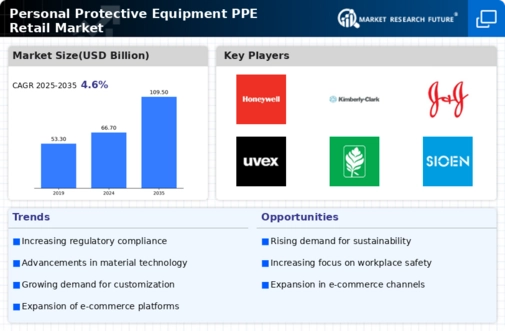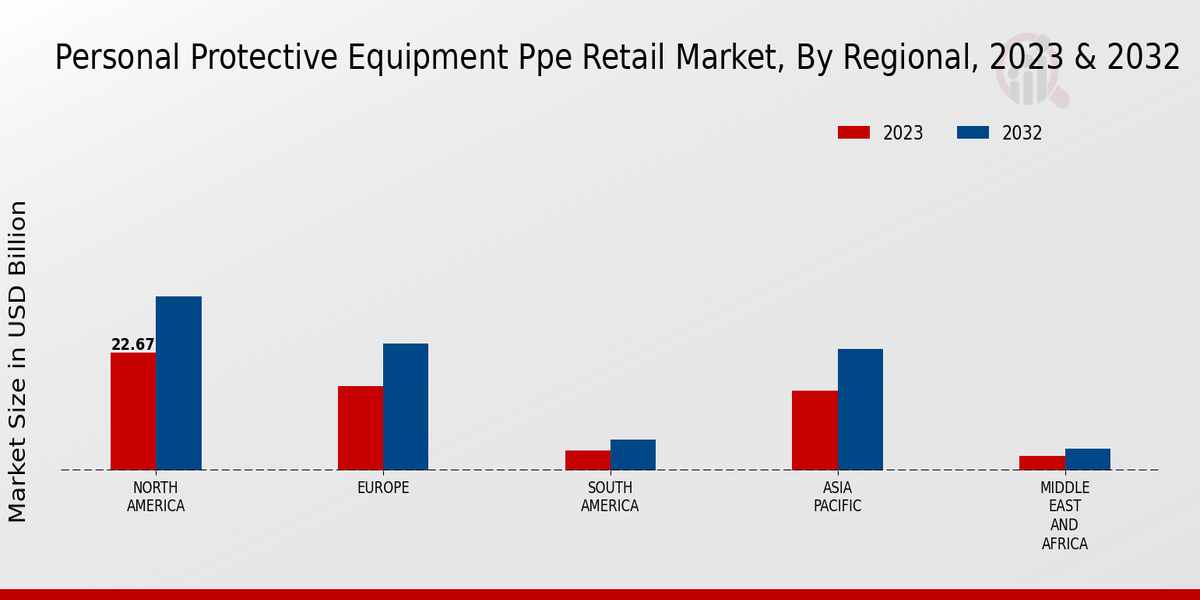Market Growth Projections
The Global Personal Protective Equipment PPE Retail Market Industry is projected to experience substantial growth over the coming years. With a market value of 66.7 USD Billion anticipated in 2024, the industry is set to expand significantly, reaching an estimated 109.5 USD Billion by 2035. This growth trajectory indicates a robust demand for PPE across various sectors, driven by factors such as regulatory compliance, safety awareness, and technological advancements. The projected CAGR of 4.61% from 2025 to 2035 further underscores the market's potential, suggesting a sustained interest in enhancing workplace safety and health standards globally.
Increasing Regulatory Standards
The Global Personal Protective Equipment PPE Retail Market Industry is experiencing growth due to the rising regulatory standards imposed by governments worldwide. These regulations mandate the use of PPE in various sectors, including construction, healthcare, and manufacturing. For instance, the Occupational Safety and Health Administration (OSHA) in the United States has stringent guidelines that require employers to provide appropriate PPE to their workers. This regulatory environment not only enhances workplace safety but also drives demand for high-quality PPE products. As a result, the market is projected to reach 66.7 USD Billion in 2024, reflecting the increasing emphasis on safety compliance.
Expansion of End-User Industries
The expansion of end-user industries is a significant driver for the Global Personal Protective Equipment PPE Retail Market Industry. Sectors such as healthcare, construction, and manufacturing are experiencing robust growth, leading to increased demand for PPE. For instance, the construction industry is witnessing a surge in infrastructure projects globally, necessitating the use of various protective gear. Similarly, the healthcare sector's growth, driven by an aging population and increased health awareness, further fuels the need for PPE. This diversification across industries not only broadens the market base but also enhances the overall growth potential of the PPE retail market.
Technological Advancements in PPE
Technological advancements are playing a crucial role in shaping the Global Personal Protective Equipment PPE Retail Market Industry. Innovations in materials and design have led to the development of more effective and comfortable PPE solutions. For example, the introduction of smart helmets equipped with augmented reality features enhances situational awareness for workers in hazardous environments. Additionally, advancements in breathable fabrics and ergonomic designs improve user comfort, encouraging wider adoption of PPE. As these technologies evolve, they are likely to drive market growth, contributing to a projected CAGR of 4.61% from 2025 to 2035.
Emerging Markets and Globalization
Emerging markets are becoming increasingly important in the Global Personal Protective Equipment PPE Retail Market Industry. Countries in Asia-Pacific, Latin America, and Africa are witnessing rapid industrialization and urbanization, leading to a greater emphasis on workplace safety. As global companies expand their operations into these regions, the demand for PPE is expected to rise significantly. Furthermore, globalization facilitates the exchange of safety standards and practices, promoting the adoption of PPE in developing economies. This trend is likely to contribute to the overall market growth, as businesses recognize the need to protect their workforce in line with international safety standards.
Growing Awareness of Workplace Safety
There is a notable increase in awareness regarding workplace safety among employers and employees, significantly impacting the Global Personal Protective Equipment PPE Retail Market Industry. Organizations are increasingly prioritizing the health and safety of their workforce, leading to higher investments in PPE. This trend is particularly evident in sectors such as construction and manufacturing, where the risk of accidents is prevalent. The heightened focus on safety training and the promotion of a safety culture within organizations further contribute to this demand. Consequently, the market is expected to grow, with projections indicating a rise to 109.5 USD Billion by 2035.





















Leave a Comment